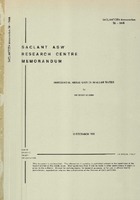| dc.contributor.author | Klemm, Richard | |
| dc.date.accessioned | 2018-10-11T14:05:48Z | |
| dc.date.available | 2018-10-11T14:05:48Z | |
| dc.date.issued | 1980/12 | |
| dc.identifier | 1624 | |
| dc.identifier.govdoc | SM-146 | |
| dc.identifier.uri | http://hdl.handle.net/20.500.12489/148 | |
| dc.description.abstract | Some results of a comprehensive model study on the use of horizontal hydrophone arrays in shallow water are presented. Well-known signal processing techniques are applied to a shallow-water sound propagation model in order to investigate the particular influence of shallow-water conditions on the design of spatial receiver structures. A great variety of array processors (optimum, suboptimum, quadratic, linear, adaptive, non-adaptive) are considered. Detection of targets in presence of directive noise sources (e.g. ships) is of particular interest. Some conclusions concerning array processor design for real-time operation are drawn. | |
| dc.format | 19 p. : ill. | |
| dc.language | English | |
| dc.publisher | NATO. SACLANTCEN | |
| dc.relation.ispartofseries | ADA095203 | |
| dc.source | In: Signal Processing, 2 (1980) 347-360. | |
| dc.subject | Sonar arrays | |
| dc.subject | Hydrophones | |
| dc.subject | Shallow water | |
| dc.subject | Acoustic propagation | |
| dc.subject | Target detection | |
| dc.title | Horizontal array gain in shallow water | |
| dc.type | Scientific Memorandum (SM) | |
| dc.type | Papers and Articles | |
